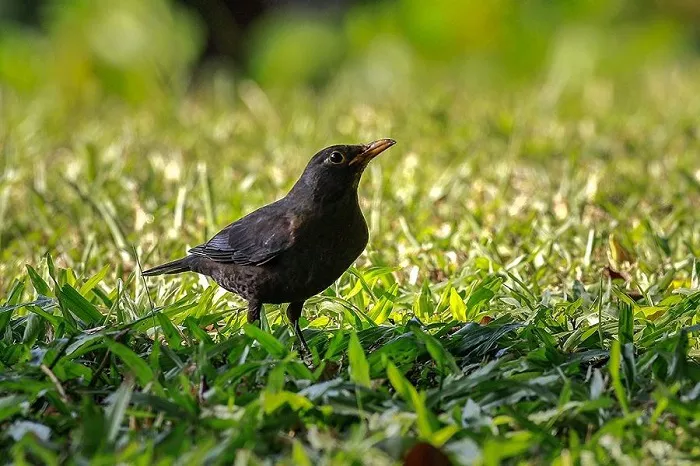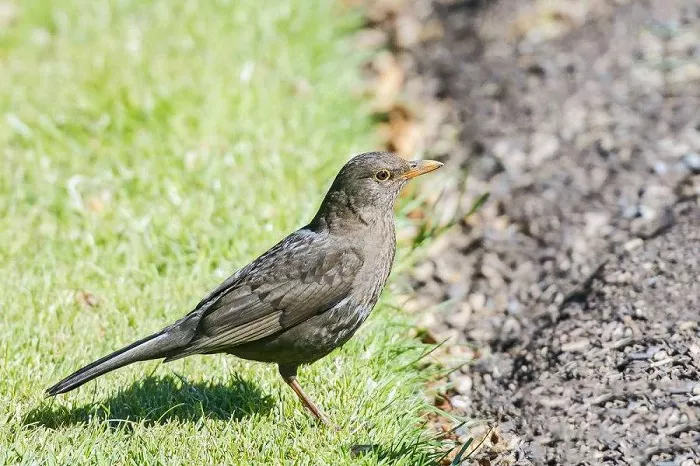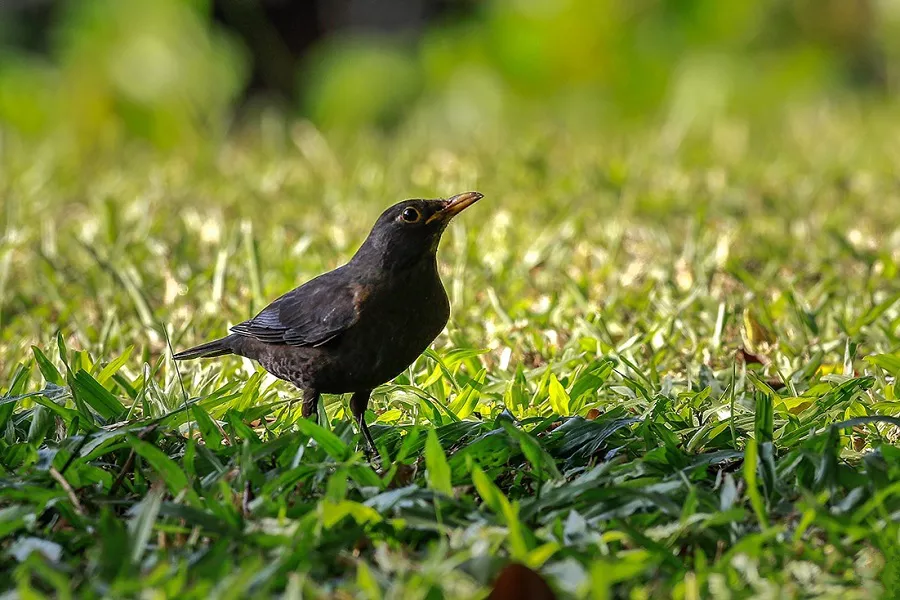The Common Blackbird (Turdus merula), is a familiar bird species found across Europe, Asia, and Western Asia. Known for its melodious song, the Common Blackbird holds a special place in folklore and literature, often symbolizing mystery and enchantment. In this article, we will explore the physical characteristics, habitat, behavior, and diet of the Common Blackbird to gain a comprehensive understanding of this remarkable avian species.
Plumage and Physical Characteristics
The common blackbird is a medium-sized passerine bird with a body length ranging from 23 to 29 centimeters. Its plumage displays an enchanting interplay of deep ebony and rich dark brown, with a subtle iridescence that reveals itself when sunlight caresses its feathers. The name “blackbird” may evoke an image of a uniformly dark creature, but close examination reveals a nuanced tapestry of colors. The male sports a striking yellow eye-ring that contrasts elegantly against his dark plumage, adding a touch of sophistication to his appearance. His bill is a vivid orange-yellow, providing a brilliant visual accent to his overall countenance. On the other hand, the female is slightly more muted in color, with her plumage bearing a browner hue, yet exuding a subdued charm.

Male Common Blackbird
Common Blackbird Habitat
The Common Blackbird primarily inhabits woodland areas, gardens, parks, and hedgerows, although it is highly adaptable and can be found in a variety of environments. Within these habitats, blackbirds typically construct their nests in dense vegetation, such as shrubs or low tree branches. Their nests are composed of grass, twigs, and other plant materials, providing a comfortable and secure space for raising their young.
See Also: 10 Common Types of Blackbirds (You Need To Know)
Common Blackbird Sound
One of the most distinctive features of the common blackbird is its melodious song. The male’s vocal prowess is a phenomenon of beauty and complexity, often reverberating through urban parks, woodlands, and gardens. His song is not only a declaration of territory but also serves as a courtship display, showcasing his vitality and genetic fitness to potential mates. This symphonic performance stands as a testament to the bird’s role as both a songster and an ecological contributor.

Female Common Blackbird
Common Blackbird Diet
The Common Blackbird is an omnivorous species, meaning it has a diverse diet that includes both plant and animal matter. Their diet varies depending on the season and availability of food sources. During the breeding season, blackbirds consume a substantial amount of invertebrates, such as earthworms, snails, spiders, and insects. They use their sharp beaks to probe the ground, flip over leaves, and extract their prey from the soil or vegetation.
In addition to invertebrates, the Common Blackbird also feeds on a range of fruits, berries, and seeds. They are particularly fond of fruits with bright colors, such as berries from hawthorn, elderberry, and blackberry bushes. Blackbirds play an essential role in seed dispersal, as they may carry seeds from one location to another after consuming fruits, contributing to the plant’s dispersal and diversity.
Common Blackbird Breeding
The breeding season for the Common Blackbird typically begins in early spring, with males establishing territories and displaying their singing prowess to attract females. Once a pair is formed, the females construct a cup-shaped nest within their chosen habitat. The nest is typically hidden and well-concealed, providing protection from predators. The female blackbird incubates the eggs, while the male actively defends the territory and brings food for his partner.
A typical clutch consists of 3-5 eggs, which are smooth and glossy in appearance, with a light blue or greenish-blue color. The incubation period lasts approximately 13-14 days, after which the eggs hatch, and the helpless chicks emerge. Both parents take part in feeding the chicks, providing them with a diet consisting mainly of insects, gradually introducing fruits and berries as the chicks grow older.
The chicks stay in the nest for around 12-14 days before fledging, but continue to depend on their parents for several weeks after leaving the nest. During this time, the parents teach them essential survival skills, such as foraging techniques and predator avoidance. The juveniles gradually acquire their adult plumage, with the males attaining their characteristic black feathers and yellow eye ring during their first autumn.
In conclusion, the Common Blackbird is an iconic species with its distinct appearance and enchanting song. Its adaptability and resilience allow it to thrive in various habitats, ranging from woodlands to urban gardens. With its striking black plumage, yellow eye ring, and melodious song, the Common Blackbird remains a beloved and familiar sight to bird enthusiasts and casual observers alike.
FAQs
Q: Do Common Blackbirds migrate?
A: Common Blackbirds are generally sedentary birds, meaning they don’t migrate over long distances. However, some populations in colder northern regions might migrate southward in the winter to find more favorable conditions.
Q: What is the song of the Common Blackbird like?
A: Male Common Blackbirds are known for their melodious and distinctive songs. They are excellent singers and their songs are often associated with the arrival of spring. Their song includes a mix of varied phrases and clear whistling notes.
Q: How do Common Blackbirds build their nests?
A: Common Blackbirds build cup-shaped nests using a combination of mud, grass, leaves, and twigs. They often build their nests in shrubs, hedges, or trees, close to the ground.
Q: Do Common Blackbirds have any predators?
A: Common Blackbirds have several natural predators, including birds of prey such as hawks and owls. They can also fall victim to domestic cats, snakes, and other ground predators.
Q: Are Common Blackbirds related to the American Blackbird?
A: Despite the similar name, the Common Blackbird is not closely related to the American Blackbird, which is a species of icterid found in North America. The two species belong to different bird families.


 Facebook
Facebook  Instagram
Instagram  Youtube
Youtube 